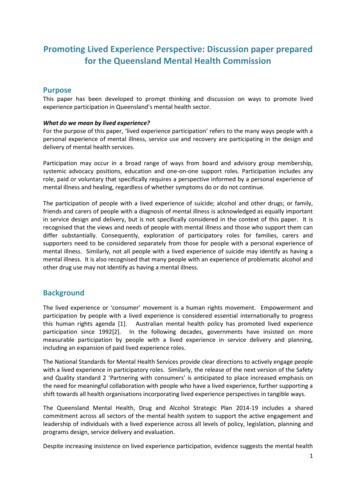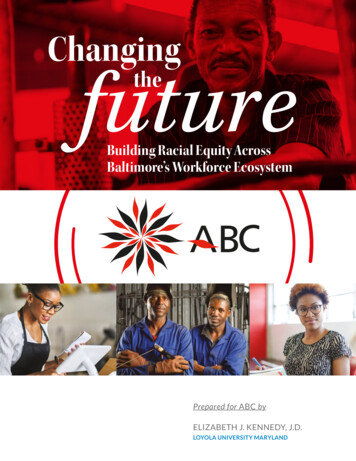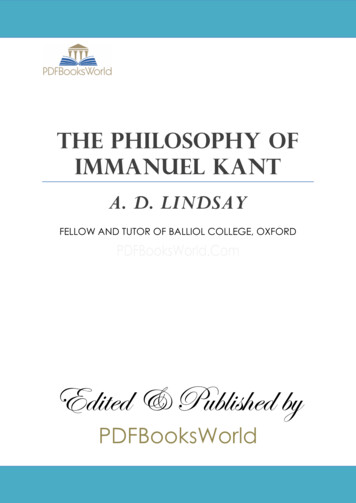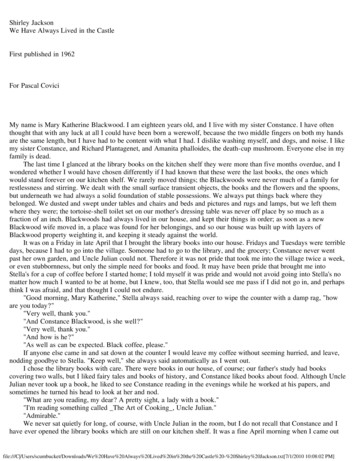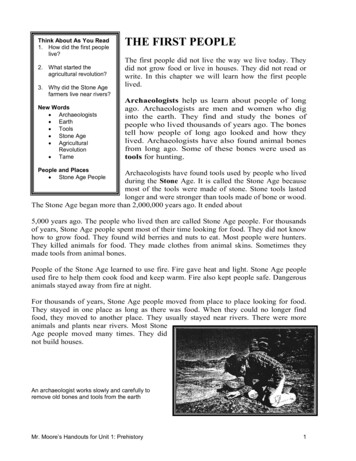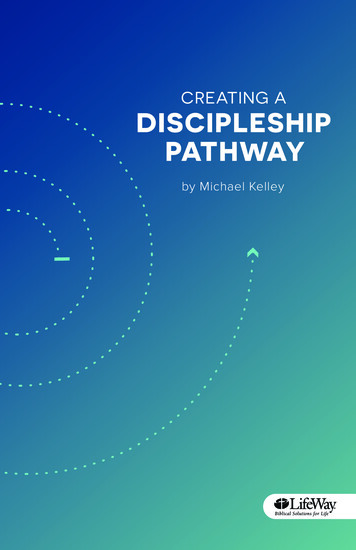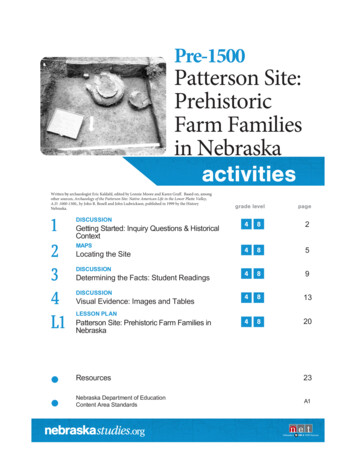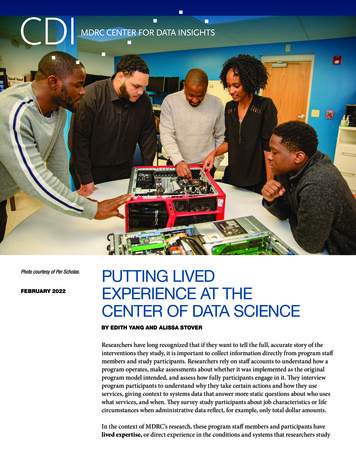
Transcription
Photo courtesy of Per Scholas.FEBRUARY 2022PUTTING LIVEDEXPERIENCE AT THECENTER OF DATA SCIENCEBY EDITH YANG AND ALISSA STOVERResearchers have long recognized that if they want to tell the full, accurate story of theinterventions they study, it is important to collect information directly from program staffmembers and study participants. Researchers rely on staff accounts to understand how aprogram operates, make assessments about whether it was implemented as the originalprogram model intended, and assess how fully participants engage in it. They interviewprogram participants to understand why they take certain actions and how they useservices, giving context to systems data that answer more static questions about who useswhat services, and when. They survey study participants about job characteristics or lifecircumstances when administrative data reflect, for example, only total dollar amounts.In the context of MDRC’s research, these program staff members and participants havelived expertise, or direct experience in the conditions and systems that researchers study
and aim to improve. People with lived expertise can include individuals or families enrolled in oreligible for a program of interest, service practitioners who work directly with these individuals andfamilies, and community leaders. Such people have a wealth of knowledge about the social issues andprograms that are studied, derived from their own experiences.1 People with lived expertise are crucial advisers on a variety of decisions, including what problems to solve, which data sources to drawfrom, what analyses to apply to them, and what visual representations of the data will be accurate,timely, and useful.MDRC’s Center for Data Insights (CDI) is dedicated to elevating the dignity of each person affectedby the programs it analyzes. It views dignity as the recognition that each person is worthy of respectand agency, and should be treated equitably and ethically. This commitment means that drawingon people’s lived expertise from project inception to the dissemination of results is central to CDI’swork.CDI has collaborated with two of MDRC’s long-standing program partners, Per Scholas and theCenter for Employment Opportunities (CEO), to create and implement tools that can more fullycapture participants’ lived experiences. These tools have been used in conjunction with existingmethods from behavioral science and data analytics to improve both program outcomes and theexperiences of participants and staff members. This brief summarizes lessons learned from thesepartnerships. Box 1 provides information about these partners’ mission and work.PER SCHOLAS: EXPLORING THE HUMANITY BEHIND PROCESS ANALYSESLike most sector-based training programs, Per Scholas uses a screening process to assess whetherapplicants are eligible and to ensure they are interested and have the aptitude to master the types ofskills they will need. An MDRC implementation study of the program found that about 80 percent ofthe people who started Per Scholas applications dropped out during the screening process and neverenrolled.2 The study reported on the stages of the Per Scholas enrollment process: a program orientation, an eligibility screen (focused on age and income requirements), an assessment of reading andmath levels (using the Test of Adult Basic Education, or TABE), verification of a high school diplomaor equivalency, staff interviews and case conferences, and finally, an intake appointment. It foundthat the most people dropped out of the process before passing the TABE assessment, so Per Scholasbegan working with MDRC to identify ways to help applicants make it past this step.MDRC data scientists in CDI ran predictive models to assess Per Scholas’s enrollment process andfound that many people who were a “good fit” for the program (at least as predicted by their background characteristics such as gender, race, ethnicity, and household composition) were dropping outduring the application process. Per Scholas’s systems data, however, could not specify why participants did not continue with the application process. The intake process captured in the data systemwas also missing some intermediate steps. For example, the systems data did not reflect what applicants had to do on their own to apply, such as actively registering for an information session afterPutting Lived Experience at the Center of Data Science2
BOX 1. ABOUT THE PARTNERSPer Scholas: Per Scholas is headquartered in the Bronx, New York, with 17 additional locations around thecountry. It is a nonprofit institute that provides training in technology skills to people from families with lowincomes, training nearly 3,000 adults in 2021. An MDRC evaluation found that Per Scholas produced largeimpacts on earnings through five years of follow-up data collection.* Program applicants need to go throughan intensive screening process to make sure their needs and interests match the program services that areoffered. As Per Scholas has increased the number of seats available in its training programs, it has neededto enroll more participants, and has continued to partner with CDI to find more eligible applicants.†Center for Employment Opportunities: The Center for Employment Opportunities (CEO) operates in 12states and 31 cities. It is a comprehensive employment program for people who are returning home fromprison, providing temporary paid jobs and other services to improve participants’ labor market prospects andreduce the rates at which they are rearrested and reincarcerated. MDRC’s study of CEO’s transitional jobsprogram showed that while employment effects faded over time, the program reduced the likelihood of arrest,conviction, and reincarceration, especially among participants who were at higher risk of those outcomeswhen they enrolled in the study.‡ CEO maintains a data system that stores extensive participant data; it haspartnered with CDI to enhance its understanding of the participants’ experiences with program services andto assess whether participants’ positive or negative feedback about their experiences are correlated withwhether they achieve program milestones.NOTES: *Kelsey Schaberg and David H. Greenberg, Long-Term Effects of a Sectoral Advancement Strategy: Costs,Benefits, and Impacts from the WorkAdvance Demonstration (New York: MDRC, 2020).†Frieda Molina and Donna Wharton-Fields, “Filling All the Seats in the Room: Using Data to Analyze EnrollmentDrop-Off,” In Practice (www.mdrc.org/publication/filling-all-seats-room, 2019).‡Cindy Redcross, Megan Millenky, Timothy Rudd, and Valerie Levshin, More Than a Job: Final Results from the Evaluationof the Center for Employment Opportunities (CEO) Transitional Jobs Program, OPRE Report 2011-18 (Washington, DC:Office of Planning, Research, and Evaluation, Administration for Children and Families, U.S. Department of Health andHuman Services, 2012).submitting an online application or making plans to prepare and study for the TABE assessment. Thedynamics of applicants’ personal life circumstances could have been either motivating or discouraging them from continuing with the application process in ways that were not being observed.To explore the application process more thoroughly, CDI used human-centered design, a problem-solving approach that focuses on the experiences and opinions of those receiving services. Withstaff members, students, and alumni, the CDI team employed customer journey mapping: a type ofprocess mapping exercise that lists the steps in a process and describes a person’s feelings, thoughts,motivations, and barriers during each step.3 The key to customer journey mapping is the development of a persona, an imagined profile representing a “typical” user, derived from a combinationPutting Lived Experience at the Center of Data Science3
of systems data and insights from people with lived expertise (in this case the participating staffmembers, students, and alumni) about users’ behavior, motivations, thoughts, and feelings. Using apersona encourages the people doing the mapping to think about the real experiences of people asthey interact with the system. For example, thinking about a persona of a working, single motherwithout a car can lead to a discussion of whether an on-site interview could be made more accommodating for people with childcare or transportation needs. The persona can also prompt discussionabout whether the process can include information about income support for people who may nothave the option of reducing their incomes because they are working less while in a training program.MDRC collaborated with Per Scholas’s team of people with lived expertise on an online collaborative platform (Miro) to create customer journey maps that reflect the potential experiences of a fewdifferent personas.The customer-journey-mapping exercise represented a turning point toward developing a moredignified application process for prospective learners. The MDRC team facilitated mapping theprocess by which people applied to and enrolled in the program and identified many additional stepsapplicants must take that were not tracked in the systems data. The intermediate steps had not beenimmediately apparent to Per Scholas staff members, who gained a fuller understanding of applicants’experience. The activity also uncovered parts of the online application that asked for informationused more for reporting and marketing purposes than for eligibility and program-fit determinations.These additional questions contributed to a prolonged and potentially intrusive application process.For example, asking about public assistance receipt on the application may have been an expedientway to collect program information for funder reports, but could make it less likely that people wouldcomplete the application, especially since they had no established or trusting relationship with theprogram provider. Per Scholas staff members deliberated whether certain questions were necessaryduring the application stage, making a priority of applicants’ experiences rather than the expedientcollection of data.CDI then used behavioral science to help Per Scholas reimagine and design an admissions processthat was less burdensome for both prospective learners and staff. (Behavioral science combinesinsights from behavioral economics, social psychology, cognitive psychology, and studies of organizational behavior to improve the experiences of people receiving services.) A pilot test of this newadmissions process demonstrated that the program could provide a more manageable and lessarduous application experience for prospective learners and still get students who were a good fit forthe program. The new admissions process reflected Per Scholas’s commitment to the dignity of itslearners. It did a better job of respecting applicants’ investments of time and effort and appreciatingtheir willingness to entrust Per Scholas with their personal information.Additionally, these conversations helped the CDI team understand experiences that were missingfrom the predictive models mentioned above (what researchers call “omitted variables”). The perspectives of people with lived expertise (in this case, front-line staff members, students, and alumni)and the use of a persona allowed Per Scholas to understand more fully what is required for applicantsto persist through the application process. Customer journey mapping allowed CDI to layer behavio-Putting Lived Experience at the Center of Data Science4
ral science methods onto insights from the predictive models so that more complete data, collected ina more dignified manner, could improve the application and eventual admissions process for prospective learners.CENTER FOR EMPLOYMENT OPPORTUNITIES: QUANTIFYINGLIVED EXPERIENCES TO REACH INSIGHTS THAT LEAD TO ACTIONCEO provides employment services and other comprehensive services to individuals who haverecently returned home from incarceration. It believes that organizations that listen to their participants and then incorporate their voices meaningfully into program decisions are better able toprovide accessible and effective services.4 In mid-2016, CEO deployed a text message survey programto “listen” to its participants by collecting feedback about the program. CEO sends a series of questions by text to participants to solicit their perspectives at important points in the program, such aswhen they complete initial training or submit their first paystubs to CEO to demonstrate that theyare actively working. It has used data from these surveys to adjust its services, for example by givingjob coaches better communication tools and altering program-activity schedules to accommodateparticipants.CEO partnered with CDI to learn about the value and the limitations of these text messageresponses. Much like other surveys fielded to study participants, CEO’s text-based surveys were subject to concerns about response and nonresponse bias—meaning people who respond to the surveyare likely to be systematically dissimilar to those who do not respond. Respondents were more likelyto engage in the program than nonrespondents, for example, and faced fewer barriers to reachingprogram milestones. As a result, the responses CEO received to the text message surveys might notreflect the sentiments or perspectives of the people who needed the most support. Indeed, when thesetext message data were quantified and incorporated into predictive job placement models, being arespondent emerged as a strong predictor of positive employment outcomes. In other words, thepeople who responded to the survey were also very likely to be the ones who enjoyed the most successin the labor market. The text responses were also overwhelmingly positive, probably reflecting somecourtesy bias (the tendency for people to understate dissatisfaction because they do not want tooffend the organization seeking their opinion).5CEO wanted to capture the missing voices of these people with lived expertise who were notresponding to the text surveys. To explore how to do so, CDI and CEO turned to CEO’s ParticipantAdvisory Council (PAC) program for guidance. This program, established in 2018, convenes groupsof CEO alumni and participants to discuss their experiences, build community and solidarity, identify systemic challenges faced by people returning home from incarceration, and promote policiesto improve their outcomes. CDI is partnering with a council formed in October 2021 to developstaff and participant interviews to capture the perspectives and reactions of program participantswho receive these text messages. The interviews are focused on gaining a deeper understanding ofwhy participants do or do not respond to the messages, and on how CEO can gain a broader arrayPutting Lived Experience at the Center of Data Science5
of perspectives to identify areas for improvement. The goals of the interviews are to reduce confusion and motivate responses among more people with lived expertise. The council has been invaluable in building an understanding of how to combat courtesy bias and collect honest responsesfrom participants. It has also guided CDI in considering how collaborating with participants mightbring harm to them if it did not take account of the traumas that participants have experienced.For example, the CDI team needed to adjust some ingrained ways of using language and words thatcould inadvertently dehumanize or retraumatize participants by evoking memories of how theywere treated while incarcerated.PUTTING HUMAN DIGNITY FRONTAND CENTER, SYSTEMATICALLYCDI’s approach to partnering with organizationskeeps people with lived expertise at the center ofits work, which in turn keeps its team of methodologists, data scientists, and experts in behavioral science focused on the goal of improvinglives. In many of MDRC’s rigorous researchstudies, researchers have used interviews, focusgroups, and surveys to provide more details thanare available in participation or administrativedata, or to enrich the story the numbers tell. Butacknowledging the dignity of each practitioneror program participant also means listeningPhoto courtesy of Per Scholas.to people with lived expertise early on andthroughout the research process: from projectdesign to data collection to data analytics to program improvement. It means reexamining each stageof the process (including what information is collected and used, and when, how, and why) to elevatethe dignity of past, current, and prospective participants. Not involving people with lived expertisein the process puts projects at risk of compromising participant experiences in order to collect dataexpediently. Information on lived experience is crucial to ensure that program participants, whowillingly allow their personal data to be used for evaluations or program-improvement purposes,are well informed and respected throughout the process, rather than becoming frustrated or beingdiscouraged from making use of potentially valuable program services.6 Guidance from people withlived expertise improves data processing and analysis and the interpretation of findings, and allowsresearchers and program operators to heighten a program’s positive effects on participants whileminimizing the risk of harm to them.Putting Lived Experience at the Center of Data Science6
NOTES AND REFERENCES1 Brian E. Neubauer, Catherine T. Witkop, and Lara Varpio, “How Phenomenology Can Help Us Learn from theExperiences of Others,” Perspectives on Medical Education 8 (2019): 90–97.2 Betsy L. Tessler, Michael Bangser, Alexandra Pennington, Kelsey Schaberg, and Hannah Dalporto, Meetingthe Needs of Workers and Employers: Implementation of a Sector-Focused Career Advancement Model forLow-Skilled Adults (New York: MDRC, 2014).3 MDRC, “Step-by-Step Guide to Creating a Process Map for Higher Education” (New York: MDRC, 2019).4 Brad Dudding, “The Core Principles of Constituent Feedback,” Feedback Blog e-by, 2019).5 Natalia Kiryttopoulou, “Overcoming the Courtesy Bias in Constituent Feedback,” Feedback coming-the-courtesy-bias-in-constituent-feedback, 2013).6 Ruth Fowler, “I Applied for LA’s Basic Income Program – and the Process Was Startling,” The Guardian(November 29, OWLEDGMENTSThe authors would like to thank our colleagues Ann Bickerton, Deni Chen, Brit Henderson, Richard Hendra,Zarni Htet, Gloriela Iguina-Colón, Clint Key, Kristin Porter, Annie Utterback, and Donna Wharton-Fields forbringing together data science, human-centered design, and behavioral science to expand our partners’abilities to serve people well. Their deep analytical work over several years has made it more possible for usto draw reliable and accurate data insights about how to improve programs. We are thankful to Nate Mandel,Ahmed Witt, and Rob Mesika at the Center for Employment Opportunities, and Bridgette Gray and Kate Boyerat Per Scholas, for their commitment to this work. Many thanks also to the Per Scholas staff members whotook part in the intensive training in behavioral science. We appreciate the generous financial support from theFund for Shared Insight, the Edna McConnell Clark Foundation, and Per Scholas that made this work possible.Thanks to Sara Ellis, Brit Henderson, John Hutchins, Richard Hendra, Clint Key, Kristin Porter, and DonnaWharton-Fields for reviewing early drafts of this document. We also thank Joshua Malbin for editing the briefand Carolyn Thomas for preparing it for publication. Most importantly, we express our deep gratitude to thelearners, participants and participant advisers, administrators, instructors, coaches, and support staff membersat Per Scholas and the Center for Employment Opportunities for their ongoing partnership with us in improvingprograms and improving lives. Their lived expertise uncovered some of the most profound data insights thatemerged from the initiatives described in this document.Putting Lived Experience at the Center of Data Science7
Dissemination of MDRC publications is supported by the following organizations and individuals that help finance MDRC’spublic policy outreach and expanding efforts to communicate the results and implications of our work to policymakers, practitioners, and others: The Annie E. Casey Foundation, Arnold Ventures, Charles and Lynn Schusterman Family Foundation,The Edna McConnell Clark Foundation, Ford Foundation, The George Gund Foundation, Daniel and Corinne Goldman, TheHarry and Jeanette Weinberg Foundation, Inc., The JPB Foundation, The Joyce Foundation, The Kresge Foundation, andSandler Foundation.In addition, earnings from the MDRC Endowment help sustain our dissemination efforts. Contributors to the MDRC Endowmentinclude Alcoa Foundation, The Ambrose Monell Foundation, Anheuser-Busch Foundation, Bristol-Myers Squibb Foundation,Charles Stewart Mott Foundation, Ford Foundation, The George Gund Foundation, The Grable Foundation, The Lizabeth andFrank Newman Charitable Foundation, The New York Times Company Foundation, Jan Nicholson, Paul H. O’Neill CharitableFoundation, John S. Reed, Sandler Foundation, and The Stupski Family Fund, as well as other individual contributors.The findings and conclusions in this report do not necessarily represent the official positions or policies of the funders.For information about MDRC and copies of our publications, see our website: www.mdrc.org.Copyright 2022 by MDRC . All rights reserved.NEW YORK200 Vesey Street, 23rd Flr., New York, NY 10281Tel: 212 532 3200WASHINGTON, DC750 17th Street, NW, Suite 501Washington, DC 20006OAKLAND475 14th Street, Suite 750, Oakland, CA 94612Tel: 510 663 6372LOS ANGELES11965 Venice Boulevard, Suite 402Los Angeles, CA 90066
tation, an eligibility screen (focused on age and income requirements), an assessment of reading and math levels (using the Test of Adult Basic Education, or TABE), verification of a high school diploma or equivalency, staff interviews and case conferences, and finally, an intake appointment. It found that the most people dropped out of the process before passing the TABE assessment, so Per .


